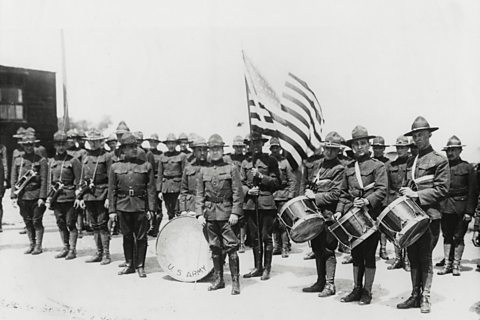The Battle of the Somme, July 1916
The Battle of the Somme is remembered as one of the most deadly battles ever fought. Over nineteen thousand British soldiers died on the first day of the battle alone.
Scottish soldiers played a crucial role in the fighting, and thousands lost their lives.
 Image source, ALAMY
Image source, ALAMYThe goal of the Battle of the Somme
The Battle of the Somme was launched on 1 July 1916. The main aim of the battle was to relieve the important northern French fortress of Verdun. This had been placed under siege by the German Army since February 1916.
With the majority of French forces tied up defending Verdun, the fighting at the Somme became the responsibility of British soldiers. Scottish battalions were at the heart of action during the battle.
Among the Scottish forces fighting in the battle were:
- 16th Royal Scots т known as McCraeтs Battalion, with strong ties to Heart of Midlothian Football Club
- 16th Highland Light Infantry - known as the Glasgowтs Boysт Brigade Battalion
Both of these battalions saw fierce fighting during the battle and took heavy casualties. It was estimated that 75% of McCrae's Battalion were either killed or wounded.
Artillery at the Battle of the Somme
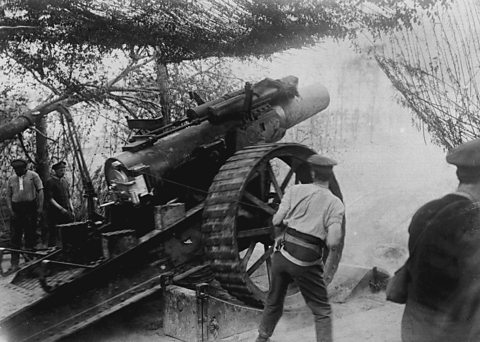 Image source, ALAMY
Image source, ALAMYFor a full week before the launch of the battle, the German trenches had been placed under constant artillery bombardment. The aim was to destroy the trenches and defences. The bombardment was so loud that it could be heard across the English Channel and as far as London.
Such faith was placed in the artillery bombardment destroying German defences, that the British troops were ordered to cross no manтs land at a walking pace.
 Image source, ALAMY
Image source, ALAMYGerman machine guns at the Battle of the Somme
 Image source, ALAMY
Image source, ALAMYThe German troops had been able to withstand the majority of the British artillery assault due to the depth and strength of their dugouts.
Once the bombardment had ended, they were able to man their machine guns and use them to mow down the advancing British soldiers.
During that first day, there were very few successes for the British. The majority of divisions suffered heavy casualties with the overall figure of wounded or dead standing at nearly 58,000.
McCraeтs Battalion (made up of players from Hearts of Midlothian FC and their supporters) reported twelve officers and 573 soldiers wounded, killed or missing at the end of the first day.
The 36th Ulster Division were one of the few divisions to achieve their objective. Rather than walking, they rushed the German front line and captured a significant length of German defences.
However they were not provided with the support that was needed and were forced to withdraw at the end of the day. Over two days, 5,500 members of the battalion were killed, wounded or missing.
 Image source, ALAMY
Image source, ALAMYLater stages of the Battle of the Somme
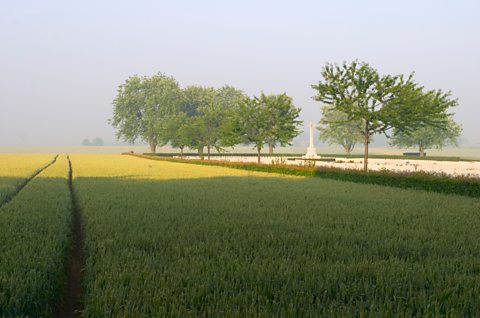 Image source, ALAMY
Image source, ALAMYWhen discussing the Battle of the Somme, many people end with the first day, however there were another two main phases of the battle before it finally ended in November 1916.
The second phase took place two weeks after the battle began. The 51st Highland Division was given the task of taking a woodland area called High Wood. Despite two brave attacks, they were unable to secure the area and sustained 3,500 casualties.
 Image source, ALAMY
Image source, ALAMYTank warfare at the Battle of the Somme
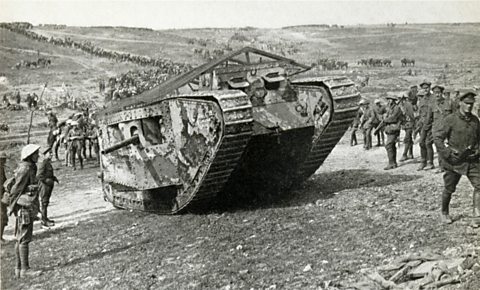 Image source, ALAMY
Image source, ALAMYDespite the losses, it was still thought that victory at the Somme was possible, and a third phase was planned and carried out in November 1916.
This phase saw the introduction of tanks to the Western Front. Although many of them broke down during the attack, they were successful at providing cover for the advancing British troops as well as scaring German soldiers.
 Image source, ALAMY
Image source, ALAMYThe 'creeping barrage' tactic
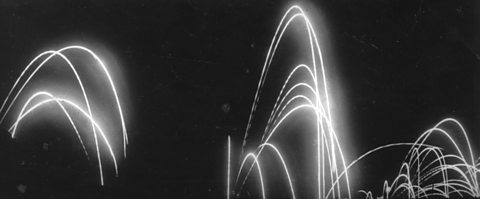 Image source, ALAMY
Image source, ALAMYThe British had analysed the failings of the first day of attack and had implemented the use of a тcreeping barrageт.
This was when the troops moved across no manтs land a short distance at a time.
Before each move, an artillery bombardment was aimed at the lines ahead, forcing the German forces to take cover and providing a veil of smoke that would conceal the advancing British soldiers.
Unlike previous attacks, this phase saw the British achieve and hold onto many of their objectives.
The 51st Highland Division managed to take Beaumont-Hamel village and did so whilst sustaining less than half the number of casualties that it had on the first day of the battle.
 Image source, ALAMY
Image source, ALAMYBravery at Frankfurt Trench
In November 1916, 120 men from the 97th Brigade т a mixture of the 11th Borders, the 16th Highland Light Infantry (Glasgow Boys Brigade Battalion), and the 2nd Kingтs Own Yorkshire Light Infantry captured and defended a portion of a large German trench known as Frankfurt Trench.
The soldiers were part of a larger British assault on the trench. The 120 men became stranded in the trench when the other British forces were forced to retreat by the Germans.
Armed only with four machine guns, with little to no food and water, the British soldiers were ordered to hold out and defend the section of the trench for two days.
Several attempts by the British Army to rescue the men failed, and so the men were left to fight alone. In the end, the men held out for eight days against constant, ferocious German attacks.
With many men badly wounded and some dead, on the eighth day the soldiers were forced to surrender. Only fifteen of them were still capable of walking.
Battle of the Somme outcomes
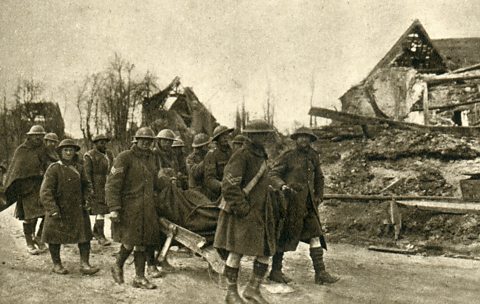 Image source, ALAMY
Image source, ALAMYThe Battle of the Somme lasted nearly five months. In terms of land gained, the British and French forces had only pushed the German Army back by six miles.
However the British attack forced the German Army to divert troops from its siege of the French at Verdun. This allowed the French to launch a successful counter attack against the German forces, resulting in their defeat.
Both the Germans and British armies lost a similar number of troops, however the Battle of the Somme is largely considered a British victory.
 Image source, ALAMY
Image source, ALAMYBattle of the Somme deaths and casualties
 Image source, ALAMY
Image source, ALAMYThe Battle of the Somme would go on to be recognised as one of the deadliest battles ever fought:
- Over three million soldiers fought during the battle
- Over one million soldiers were either killed or wounded
- Over 57,000 British soldiers were casualties on the first day of the battle
- Of those casualties, 19,000 British soldiers were killed
Source: Imperial War Museum.
The terrible casualty rate of the first day of the battle led to it being called the bloodiest day in British military history.
The British public at home was shielded from the horror. A film of the battle was shown in cinemas and viewed by an estimated 20 million people. The film showed only positive scenes of British soldiers at war. (Source: Imperial War Museum).
After the war, for many people, the Battle of the Somme summed up modern, mechanised warfare.
The historian A.J.P. Taylor summed up the battle:
The Somme set the picture by which future generations saw the First World War; brave helpless soldiers; blundering obstinate generals; nothing achieved.
 Image source, ALAMY
Image source, ALAMYTest your knowledge
More on World War One
Find out more by working through a topic
- count6 of 9
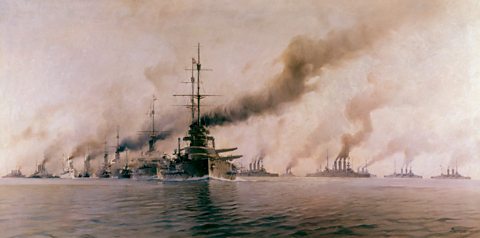
- count8 of 9
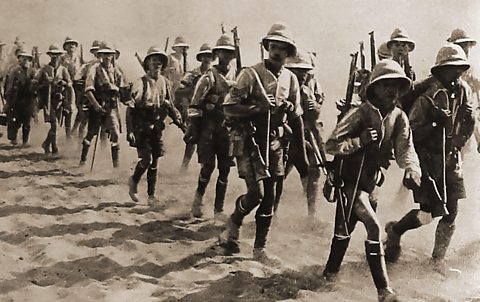
- count9 of 9
